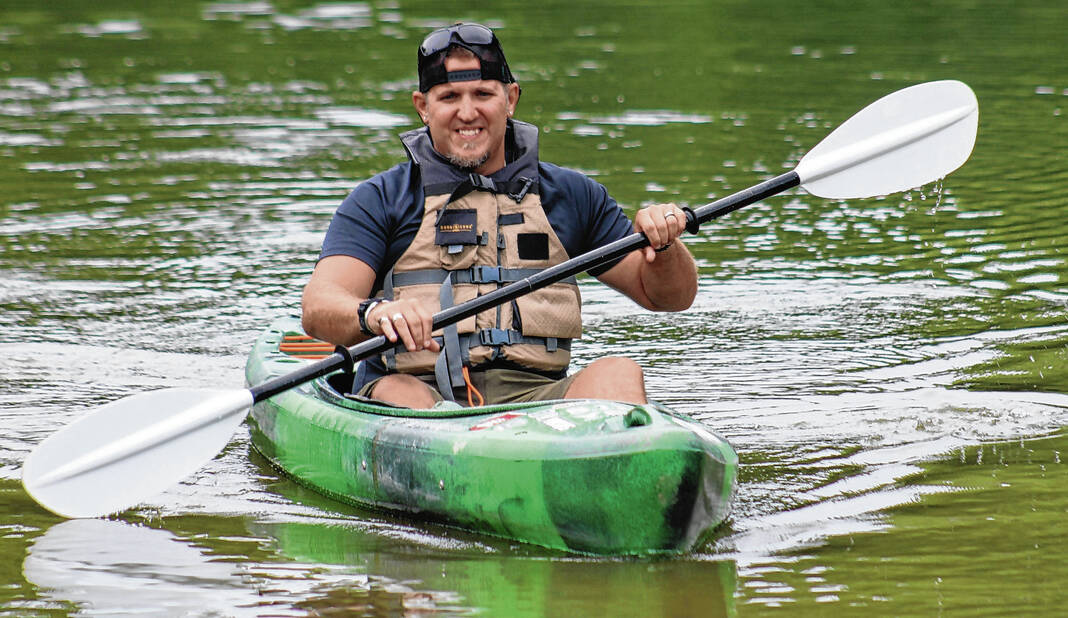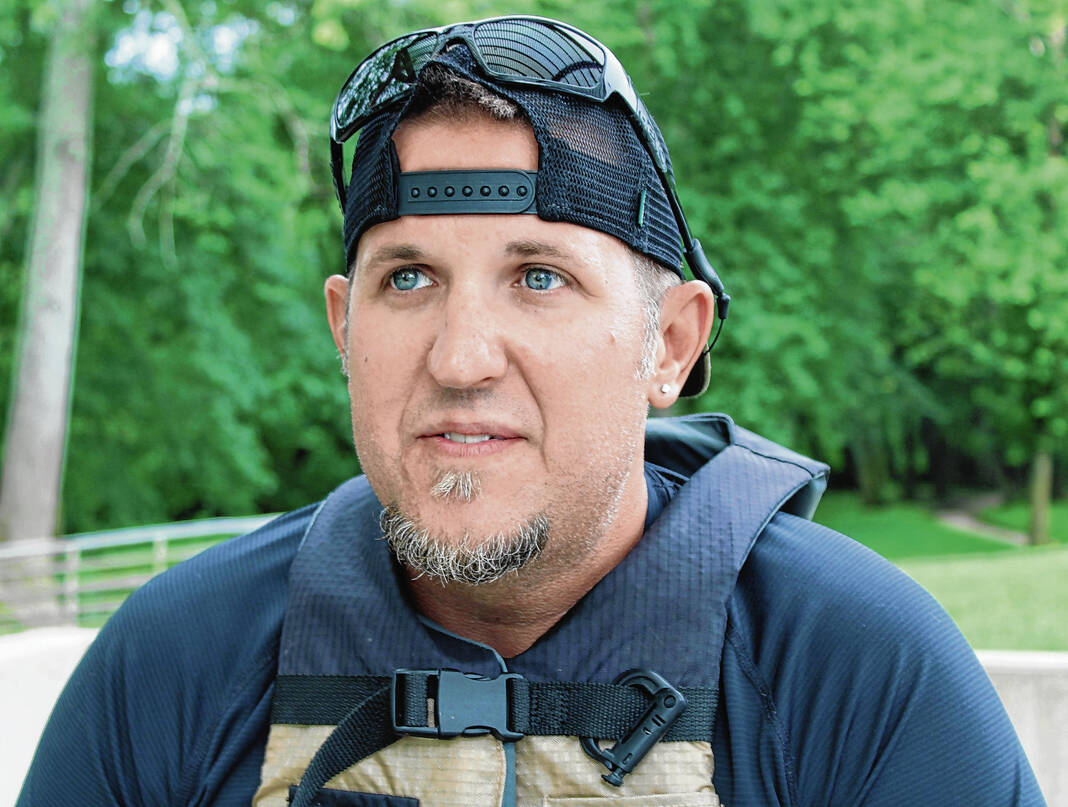COLUMBUS — Toby Stigdon stroked the white-tipped paddles into the White River, barely making ripples during his gentle kayak propulsion as preparation for the giant task ahead.
It was late morning in early August, and the sun was surprisingly bright for a day that forecast rain. The combination of circumstances essentially defined Stigdon’s life.
Kayaking, his major outdoors activity. Sunshine, as in his personality. Bad weather coming, as in the looming and ever-present threat from a terminal cancer diagnosis.
Poorly differentiated thyroid cancer that first troubled him in April 2021 has spread to his lungs with tumors, and doctors tell him it is untreatable and they can only say he doesn’t have long to live.
Stigdon is a dying man, though one with a mission, a cause, embraced through his lifelong passion for the outdoors.
“I love the outdoors,” he said. “I love the water.”
Stigdon, 42, who grew up in Seymour and graduated from Seymour High School in 1998, is married, and he and Samantha, his wife of 15 years, have two children, a boy, Chase, 13, and a girl, Olivia, 8. Samantha has a good job, and Stigdon works half-time in a day care after a 15-year career as a senior citizen activities director at different centers in Indiana and South Carolina, so his medical coverage is good.
Yet he is spearheading a fundraising drive with an adventure theme called Kayaking for Cancer, a 66-mile paddle on the East Fork White River from Columbus, through Seymour and Brownstown, ending near Medora at the confluence of the Muscatatuck and White rivers.
He has the modest goal of raising $6,600, a dollar per mile, $66 at a time for those who contribute with all of the money going to the Schneck Foundation in Seymour for contributions to financially needy cancer patients.
None of the proceeds are for him.
Being blindsided by a terminal disease diagnosis is a shock for anyone. Stigdon said he has tried to be strong for his family and has only cried a little bit in private.
“I’m not mad,” he said while sitting at a bench at Mill Race Park gazing at the nearby water. “I’ve had a lot of love in my life.”
What makes him angry, Stigdon said, is when he hears of other cancer patients who can’t afford needed treatment, the cost even of gasoline to drive to medical facilities or other shortfalls. That’s who and what this money is for.
Kayaking for Cancer
The flyers Stigdon is repeatedly posting on Facebook and the information he is spreading tell a succinct story of the Kayaking for Cancer plan and the reason behind it.
The paddle is scheduled for Oct. 7 to 9, broken into three daily segments. Stigdon will be accompanied by his cousins, B.J. and J.R. Strong.
Since they were youths, the trio has spent time together camping, hiking, fishing and kayaking, and the Strong brothers want to be there for Stigdon.
“It’s sad,” said J.R., 40. “We can do one more thing with him.”
Sharing the trip with his tight relatives is important to Stigdon. He is 5-foot-11, weighs 230 pounds and has arm muscles that would appear to easily handle paddling 66 miles. But he also concedes he might need the Strongs’ help to stay strong. That sometimes happens.
“I have my good days and bad days,” Stigdon said of the way cancer affects him. “I have fatigue. I have some dizziness. I have short-term memory problems.”
Stigdon’s attitude — raising money to help strangers and not seek any money to apply to his own situation — has impressed others.
Stephanie Flinn, executive director of the Schneck Foundation, a partner with Stigdon on the kayak trip, virtually portrays him as a hero. She called the Kayaking for Cancer different from many sports fundraising events because Stigdon is putting 100% focus on other beneficiaries.
“This is a sad story,” Flinn said of Stigdon’s plight. “But then he accepted his diagnosis and he set his mind on supporting others he will never meet.”
The Schneck Foundation, established in 1953, will use 100% of the money raised by Stigdon for treatment of patients at the Don and Dana Myers Cancer Center filling gaps in cancer coverage, and donations are tax-deductible.
Flinn has become nearly overwhelmed by Stigdon’s outlook handling his bleak situation.
“If I had that kind of diagnosis, I would hope to accept it the way he has,” Flinn said. “He is an inspiration. He makes you want to be a better person. I’m in awe of him.”
Seymour roots
Stigdon was raised by Seymour grandparents Walter and Marilyn from the age of 2. Walter died some years ago, but Marilyn still lives in town. They were a great influence on him, leading to his career working with senior citizens after attending Indiana State University.
He met Samantha in college and became an activities director at a variety of senior centers, including one in South Carolina for five years but otherwise in Indiana.
“It seemed like a natural fit,” he said of his closeness with his grandparents and how it led him to tailor individual programs for older individuals.
Sometimes, when seniors move into a home, they are depressed, he said, with the attitude they were just waiting to die there. Stigdon’s response matches the one he is living himself now as he copes. He told seniors, “You can still do anything you used to.”
Stigdon helped one former Negro Leagues baseball player come out of the shadows, arranging for him to be honored at a minor league baseball game in South Carolina. He designed educational programs recognized with awards.
After his cancer diagnosis, Stigdon down-shifted to working half-time locally in a day care, making sure he spends every available free hour with family.
One day when he took Chase kayaking, Stigdon said he sensed the boy didn’t really want to be out there. A moment of sadness overtook him because Stigdon thought, “I didn’t know how many more days I would have with him.”
Cancer discovery
In April 2021 when Stigdon weighed 40 pounds more and wasn’t in the athletic shape he is now, he was lifting weights with Chase, who was trying to bulk up for school sports.
Later, Stigdon had some pain in his neck and thought he had pulled a muscle. Samantha noticed a large lump on the neck and said, “That’s your thyroid.”
Stigdon visited a doctor and was referred to the Indiana University Health Simon Cancer Center in Indianapolis. He underwent surgery the next month and received the life-shattering news, told he had a year to live.
“I tried not to cry,” Stigdon said. “My wife was breaking down. I tried to stay calm.”
The thyroid disease resisted chemotherapy and other treatments, and cancer spread to Stigdon’s lungs. It is not known how he contracted the disease, but there is some speculation it was a long time progressing.
“They said I could possibly been living with it for years and it has mutated,” Stigdon said.
Stigdon makes for a powerful physical appearance, and he has brought that type of mental attitude to his fight. He reflects on family and friends and people he helped in his professional life and talks bravely.
“If it’s my time, it’s my time,” he said. “I’ll accept it. I’ve got a lot of memories.”
Briefly, his blue eyes teared up and he looked away, once again gazing at the water.
Kayaking for others
Samantha was not an outdoors person when she met Toby, but since college, she has joined him camping, hiking, kayaking and fishing.
When he devised the idea for Kayaking for Cancer, she wasn’t sure he was able. A few weeks ago, he told her he was serious.
“I just want to make an impact,” he said. “This is what I want to do.”
One thing Samantha learned about river kayaking is “You kind of let the river do the work for you.”
Samantha thought over her husband’s plan and realized, “I think it’s very fitting for him” because of the joy Stigdon takes in the outdoors. “But I didn’t want for him to do it alone.”
Enter B.J. and J.R., longtime outdoors companions.
“When he first got diagnosed, it was hard to wrap my head around it,” B.J. said. “It’s hard.”
Then he and Stigon made a bucket list, and when Stigdon brought up Kayaking for Cancer, B.J. said, “Well, I’m in.”
The game plan will likely have them put into the water in Columbus at 6 a.m. Oct. 7. When they knock off in Seymour, they will probably fish from shore and maybe have freshly caught catfish for dinner.
“I think it is awesome to do it for other people,” J.R. said.
When they finish, with any kind of goodwill, they should have their $6,600 in pledges or payments. Flinn predicted the fundraiser will “absolutely be a success.”
Stigdon said it made sense to start small. But just maybe “God willing, we can think bigger and can go higher” a year later.
Somehow, Stigdon would love to paddle Kayaking for Cancer II in 2023, too, outwilling his doctors and body following the gentle flow of the river.







